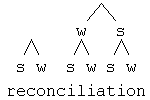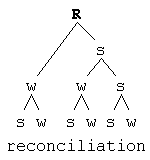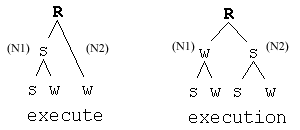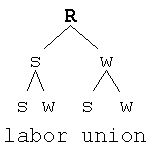3.2.3 - More Complex Polysyllabic Words
Obviously not all polysyllabic words have only one stress. Many have two or more. The WORD RULE explains how to build up the tree structures of words with more than one s; here again, the rule emphasizes the way stress is relative and hierarchical. Liberman states the Word Rule as follows: "In a pair of sister nodes N1 N2, N2 is s if and only if it branches" (Liberman, "On Stress and Linguistic Rhythm" 268). A node is a branch of a tree structure above the first level of w's and s's. Sister nodes are branches at the same level of analysis. Compare the branching and stress patterns in "execute" and "execution." In "execute," N2 does not branch so the stress falls on "ex." In "execution," both "ex" and "cu" are s at the first level of analysis. But here N2 does branch, making the strongest stress fall on "-cution," as indicated by the s at the second level of analysis.
(6)
It may be useful to take another example that will demonstrate both the Word Rule and the steps for connecting the nodes of the tree in a more complex word. Take the word "reconciliation" (Liberman and Prince 268).
(7)
a. First assign s's and w's according to your everyday knowledge of pronunciation or with the help of the dictionary.

b. Working from the end of the word leftward, stop at the first s and construct a branched node connecting the s with the first w on its right.

c. Repeat this process with each of the other s's.

d. Use the Word Rule to construct the relationship among the paired nodes. Again working from the end of the word, you see that "-ciliation" consists of two nodes, N1 and N2 and that N2 branches. Thus, the strongest s in this pairing will be on "-ation."

e. Now join "recon-" to the rest of the word. At the next level of tree structure, "-ciliation" is branching so it must again be assigned an s, while "recon-" is weak. Finally, root your tree at the top with an R to show that all the material under analysis has been accounted for.

COMPOUND WORDS are a peculiar type of polysyllabic words and they do not follow the Word Rule. The Word Rule applies only within words themselves and not across word boundaries. So while some compounds may appear to have the same branching structure we saw in "execution," for example in "labor union," the rule does not apply here. Instead, compounds have their strongest stress as far forward in the word as possible. So the proper tree structure for "labor union" looks as follows.
(8)
Assign s's, w's and tree structures to the following words: epidermal, honeysuckle, lawn-mower, falsification.

